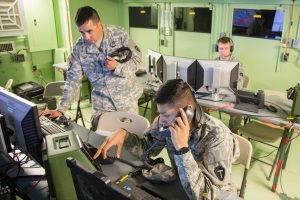Communication Soldiers critical to MIBT success
Story by: Spc. Christina Clardy
Posted on: June 21, 2016
 Photo By Maj. Randall Stillinger | Sgt. 1st Class Juan Martinez, the Tactical Action Center Non-Commissioned Officer In Charge and Pvt. Gerardo Romano, a truck driver with 36th Inf. Div., monitor the communications systems at the Tactical Action Center during the Multi-Echelon Integrated Brigade Training exercise at Fort Hood, Texas. Communications Soldiers provided equipment and support for the higher headquarters division staff which communicated with several Active and reserve component units. (U.S. Army photo by Maj. Randall Stillinger, 36th Infantry Division Public Affairs)
Photo By Maj. Randall Stillinger | Sgt. 1st Class Juan Martinez, the Tactical Action Center Non-Commissioned Officer In Charge and Pvt. Gerardo Romano, a truck driver with 36th Inf. Div., monitor the communications systems at the Tactical Action Center during the Multi-Echelon Integrated Brigade Training exercise at Fort Hood, Texas. Communications Soldiers provided equipment and support for the higher headquarters division staff which communicated with several Active and reserve component units. (U.S. Army photo by Maj. Randall Stillinger, 36th Infantry Division Public Affairs)
Soldiers from the 36th Infantry Division, Texas Army National Guard, set up and provided division-wide communication channels during a Multi-Echelon Integrated Brigade Training exercise, June 4-18 at Fort Hood, Texas.
The Texas Army National Guard division serves as the higher headquarters during this Multi-Echelon Integrated Brigade Training (MIBT) exercise for a brigade and several specialized units as they train to meet requirements for their annual training cycle. The exercise will be focused on maneuver-based, decisive action and will include critical gunnery training on various weapons systems.
"The division's role in this exercise is to act as a higher headquarters for the [Brigade Combat Teams] and other units out in the field," said Maj. Gen. Lester Simpson, commander of the 36th Inf. Div. "Many BCTs are in states that do not have a higher headquarters, so here they can train and practice working with one."
Preparation began months in advance as network, signal and communications teams from the 36th Inf. Div., planned and organized equipment and systems to support the two-week exercise. Nearly 5,000 Soldiers and nine units from the U.S. Army, U.S. Army Reserve, and the Texas and Mississippi National Guard participated in the training.
"In February, we had a full server refresh and rebuild," said Master Sgt. Brandon Horta, the 36th Inf. Div. Communications Noncommissioned Officer in Charge. "So we did a lot of network reengineering and reconfiguring of the Tactical Mission Command server."
The command staff from the participating units had concerns about the connectivity of the Army Battle Command Systems required to track and control the moving pieces in the simulated battlespace.
"Due to the varying fielding schedules, not every unit participating in this exercise had the same versions of the many systems we use to communicate," said Simpson. "Without the same versions, the systems cannot cross talk."
The various U.S. Army, U.S. Army Reserve and National Guard units solved this by system tests, double-checking software consistencies and frequent conference calls with each other across six time zones for months in advance. According to Simpson, this early preparation was key for successfully setting up the MIBT and allowed the exercise to kick off with all the units on the same playing field communications-wise.
An advance party of mostly communications Soldiers arrived May 28, and began setting up more than ten types of transmitter and relay systems, the Army Battle Command System, a Tactical Mission Command server and various unit tracking systems.
"The biggest challenge when we got here was the unforgiving terrain [due to the recent severe flooding in and around Fort Hood]," said Horta. "Several units had to move locations and we had to adjust our communication relays and retransmissions sites to provide the best connections."
One site, manned by a dozen Soldiers in rotating shifts, maintained a FM radio retransmission antennae and a High Capacity Line-Of-Sight Radio dish. The dish is a tri-band antennae system that requires line of sight from dish to dish to provide faster data transfer for reconnaissance video and intelligence systems.
"It took us about a day to set up and sync the dish and the FM antenna," said Pfc. Stephen Lewis, a 24-year-old computer information specialist with Signal Company, Headquarters and Headquarters Battalion, 36th Inf. Div. "The hardest part was keeping the antennas up and linked. The first week, it rain more than half the time we were up there making the ground soft and muddy."
Despite the challenges, the communication Soldiers were able to successfully provide the necessary systems connectivity allowing the operations centers, headquarters units and ground troops to remain in contact throughout the division's portion of the exercise.
For the 36th Inf. Div. staff, the MIBT exercise is the first step in preparing for the division's Warfighter 2018 rotation in eighteen months. Warfighter is multi-year preparation training event culminating in a simulated exercise that allows units from brigade to division to corps, to integrate command systems, and execute large-scale missions and operations.